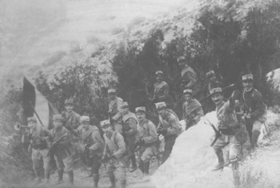French Armenian Legion
This article needs additional citations for verification. (May 2015) |
| Eastern Legion / Armenian Legion | |
|---|---|
 | |
| Active | 1916–1920 |
| Country | |
| Size | Six battalions (1916) |
| Engagements |
|
| Commanders | |
| Notable commanders | Commandant Louis Romieu |
The Armenian Legion (French: Légion Arménienne) was a volunteer unit that was raised by the Allied Powers to serve in the Middle East Theatre during World War I. Trained and led by French army commanders, the Légion d'Orient (Eastern Legion), as the unit was originally known, was created in 1916, its ranks chiefly drawn from Levantine and Armenian exiles and refugees from the Ottoman Empire. In 1919, it was renamed the Légion Arménienne (Armenian Legion).
Background

The establishment of an Armenian fighting force was first proposed by
Establishment
Negotiations of Boghos Nubar with French political and military authorities culminated in the formation of the French Armenian Legion.[citation needed]
The Legion was established officially in Cairo, Egypt in November 1916, with the accord of the French Ministry of Foreign Affairs and an Armenian delegation. Several Armenian organizations pledged contributions to form several battalions under the planned Armenian Legion.[citation needed]
The parties agreed to the following:[citation needed]
- The aim of creating the Legion was to allow Armenians' contribution to the liberation of the Cilicia region in the Ottoman Empire and to help them to realize their national aspirations of creating a state in that region.
- The Legion was to fight only Turks and only in Cilicia.
- The Legion was to become the core of a planned future Armenian Army.
Initial plans
Signed in Paris by General Pierre Roques, Minister of War, and General Marie-Jean-Lucien Lacaze, Minister of Navy, the official decision regarding the establishment of the Armenian Legion was signed on 15 November 1916 in Paris.[citation needed]
According to this initial decision,[citation needed]
- The Eastern Legion was to be stationed in Cyprus
- Armenians and Syrians of Ottoman nationality would be permitted to volunteer
- The Legion would be commanded by French officers
- Volunteers for the Legion would have an equivalent status compared to French soldiers and would be under the responsibility of the French War Ministry
- Major Louis Romieu would supervise the establishment of the Legion
- The Legion was to be deployed in Cilicia, on the southeastern coast of Asia Minor (modern Turkey)
- 10,000 Francs were to be allocated from the war budget of the French Navy to use in the establishment of camps
- The volunteers were to be organized by local Armenian committees and sent to Bordeaux and Marseille. The committees were to be reimbursed by French government for travel expenses.
Order of Battle, 1916–1918
This section may be unbalanced towards certain viewpoints. (August 2020) |

The number of volunteers was an equivalent of 6 battalions, each containing 800 volunteers, and another 6 battalions were planned to be formed. Armenian committees were organizing to recruit these soldiers in France and the United States.[citation needed]
The Legion included Ottoman Armenian refugees, former prisoners of war, and permanent residents of Egypt, America, and Europe, and was 95% Armenian in composition. The majority of the soldiers were said to be recruited from the Armenian-American community or survivors of the battle of Musa Dagh who were living in refugee camps in Port Said, Egypt, at the time.[citation needed]
After the initial training in Cyprus, the Armenian Legion joined the
Under the command of General
Order of Battle, 1920–1921
Following this campaign, the Armenian Legion was deployed in Anatolia (Asia Minor) according to the initial decisions. They were active around the cities of Adana and Mersin and involved in skirmishes with local civilians and unorganized Turkish militia.
References
- ^ Historical Service of the French Army. Les armées françaises dans la Grande guerre: Théatre d'opérations du Levant (Paris: Imprimerie Nationale, 1936), vol. 9, pt. 1, p. 97.
- ^ Richard G. Hovannisian, Armenia on the Road to Independence,' 1967
- ^ King, William C. (1922), King's complete history of the World War : visualizing the great conflict in all theaters of action, 1914-1918, Springfield, Massachusetts: The History Associates, p. 666
Further reading
- Pattie, Susan Paul (2018). The Armenian Legionnaires: Sacrifice and Betrayal in World War I. I.B. Tauris (Bloomsbury). ISBN 978-1-78831-125-0.
See also
- Armenian Legion (disambiguation)
- Franco-Armenian relations
- French Foreign Legion
